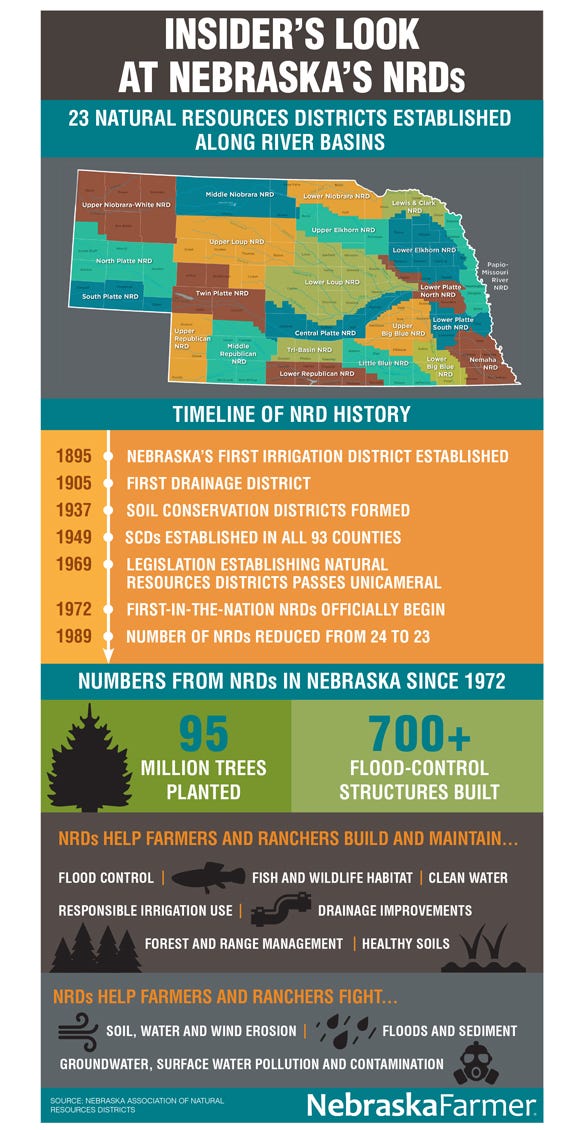
Since the Nebraska natural resources districts system of 23 NRDs was begun officially in 1972, the NRDs have been anything but a sole player in conservation management.
Many of the greatest conservation successes have come from partnership efforts with farmers, the Natural Resources Conservation Service, Nebraska Extension, other conservation agencies and agribusiness, according to Dean Edson, executive director of the Nebraska Association of Natural Resources Districts.
When it comes to irrigation management and groundwater protection, Edson is quick to cite partnerships with the state's center-pivot manufacturers and irrigation technology companies as the reason for the success.
"Our great partnerships with conservation agencies like NRCS and Extension, as well as agribusiness and our producers, have led us to utilize new irrigation tools like soil moisture probes and telemetry to monitor and operate center pivots," Edson says. "Because we have taxing authority, NRDs also have the funding to raise money locally to cost-share with producers" on technologies that improve irrigation efficiency and reduce water loss and cost.
Central Platte NRD has a long list of partners that have assisted in several key strategies along the Platte River basin. Its general manager, Lyndon Vogt, cites the Crop Irrigation and Demand Network as an example. "Started in 2013, this program receives data collected by McCrometer Connect telemetry, which provides a vast amount of real-time data," Vogt explains. "The program allows the NRD to view information, such as the amount of water pumped and soil moisture from fields where producers have installed telemetry equipment. Landowners can check their own readings, such as gallons per minute, inches applied each day throughout the season and soil moisture readings through a website."
He notes that the amount of water pumped and precipitation are measured at selected locations to provide data to develop irrigation efficiencies by irrigation equipment type, soil water-holding capacity and crop type.
According to Vogt, the project started with a budget of $60,000 but was expanded the following year, thanks to a $750,000 grant from the Nebraska Department of Natural Resources. With additional partners Seim Ag Technology and McCrometer, the program has grown to 86 sites across the NRD, with water pumped, system pressure and rainfall being monitored at all locations, as well as soil moisture at 30 of the locations.
Cover crop research
Vogt also cites a Central Platte NRD partnership with Nebraska Extension, NRCS, Arrow Seed and Green Cover Seed to research the impact of cover crops on soil health within the district. "Field days are held annually to show practices like cover crop mixes planted on different dates and comparing aboveground biomass with below ground, as well as the best mixes for grazing," Vogt says. "Research includes whether compaction and infiltration are impacted, how biological activity and organic matter are affected, which mixes provide the highest-quality forage for grazing and how much crop-usable nitrogen can be expected."
This program also ties to groundwater. "In 2017, Central Platte and Lower Loup NRDs hired EA Engineering Science and Technology Inc., Lincoln, Neb., to conduct a four-year study to determine the impact of cover crop management on groundwater," Vogt says.
"The NRDs split the cost and are seeking assistance to identify and develop grant applications to aid in funding the study." The Lower Loup and Central Platte basins have diverse soil types and cropping practices that impact both water quantity and quality, he adds. This study will determine the general influence of cover crops on soil moisture, groundwater recharge and movement of nitrates in the soil,” he says.
"This study will include both irrigated and dryland cropped fields and span multiple years," Vogt says. "Landowner identification, mobilization and installation of field equipment began this past fall, with a final study report to be presented in March 2021."
You can learn more about NRD partnerships like these examples happening across Nebraska by going to nrdnet.org.

About the Author(s)
You May Also Like






